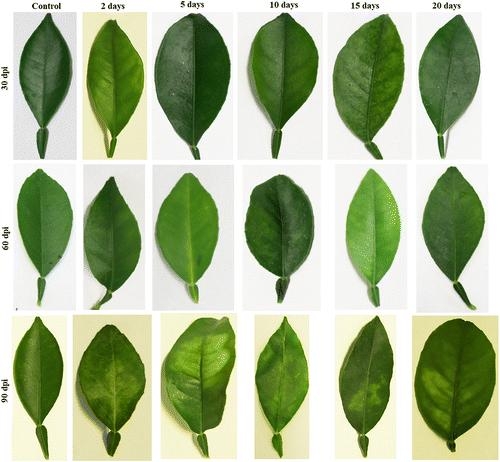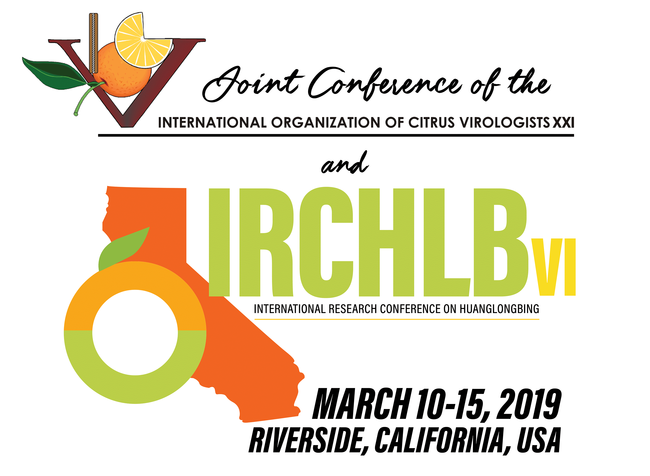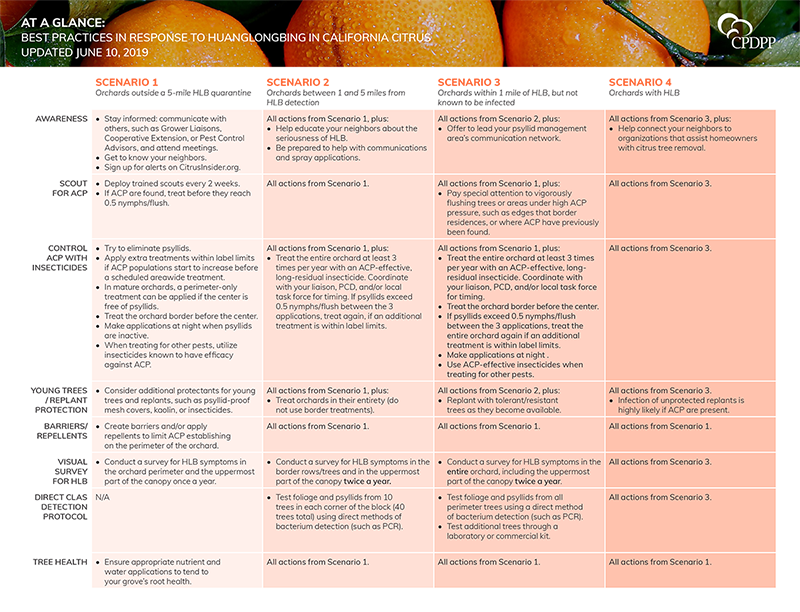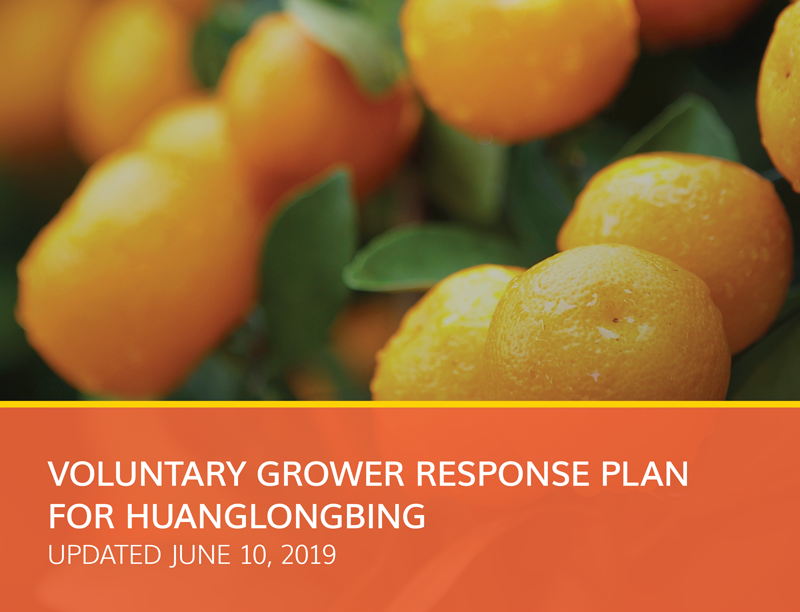
Posts Tagged: ACP Asian citrus psyllid
First study to compare citrus varieties with combination of metabolomics and microbiome
Citrus greening disease, or Huanglongbing (HLB), is deadly, incurable, and the most significant threat to the citrus industry. Most HLB research focuses on the tree canopy, but scientists in California studied the impact of HLB on root systems. They recently published the first study to report on the response of two different varieties of citrus to the causal bacterium, 'Candidatus Liberibacter asiaticus' using metabolomics and microbiome technologies.
"Metabolomics is a cutting-edge field of study that provides snapshot information about the metabolism of living things," explains author Emily M. T. Padhi, "while microbiome studies provide valuable information about the microbial communities living in a particular ecological niche - some microbes are beneficial to the host, while others can be harmful."
Padhi and colleagues wanted to see how the root system of two varieties of citrus responded to HLB. They collected roots from healthy and infected Lisbon lemon and Washington Navel orange trees grown in greenhouses at the same time and under the same conditions.
They found that both varieties experienced a reduction in root sugars and amino acids when exposed to HLB. However, they also found differences. While the concentration of malic acid and quinic acid (two metabolites involved in plant defense) increased in the navel roots, they decreased in the lemon roots. They also found that the beneficial bacteria Burkholderia increased substantially in navel plants but not in lemons, which contradicts previous studies.
"Overall, this is the first study to compare two varieties of citrus using a combined metabolomics and microbiome approach and demonstrates that scion influences root microbial community composition and, to a lesser extent, the root metabolome."
There is evidence to suggest that the causal bacterium moves to the root system soon after a plant becomes infected. A key strategy for preserving the health of an infected tree is root system management and research on different responses to HLB may help devise new variety-specific preventative and treatment measures.
Emily M. T. Padhi Nilesh Maharaj Shin-Yi Lin Darya O. Mishchuk Elizabeth Chin Kris Godfrey Elizabeth Foster Marylou Polek Johan H. J. Leveau and Carolyn M. Slupsky
https://apsjournals.apsnet.org/doi/10.1094/PHYTO-03-19-0103-R
Images of the bulk root mass and sample leaves from healthy and 'Candidatus Liberibacter asiaticus' lemon and navel plants.
Credit: Emily M. T. Padhi, Nilesh Maharaj, Shin-Yi Lin, Darya O. Mishchuk, Elizabeth Chin, Kris Godfrey, Elizabeth Foster, Marylou Polek, Johan H. J. Leveau, and Carolyn M. Slupsky

HLB infected roots
ACP/HLB UPdates
This is the most recent news about the status of Huanglongbing and Asian Citrus Psyllid in the San Luis Obispo, Santa Barbara and Ventura areas, as well as links to activities in the state. Cressida Silvers is the local Grower Liaison for the Ca Dept of Food and Ag's Citrus Pest and Disease Prevention Program.
HLB Update
The most recent map and totals for all HLB detections in the state are posted at the website maps.cdfa.ca.gov/WeeklyACPMaps/HLBWeb/HLB_Treatments.pdf. As of November 1, a total of 1,665 trees and 264 ACP have tested positive for the bacterium that causes HLB, on a total of 1,197 sites, all still in LA, Orange, and Riverside Counties. To date, all HLB detections have been on residential properties, the infected trees have been or are being removed, and ACP treatments applied on a recurring basis to remaining citrus in those areas. No HLB has been found in commercial groves via PCR testing.
How Close Is HLB To Your Citrus? There's a New UC App For That!
Visit ucanr.edu/hlbgrowerapp , zoom to or type in your location and it shows your proximity to HLB+ detections, recommends best practices to protect your citrus from HLB based on your current proximity to known detections, and provides a link to the Voluntary Grower Response Plan for more information. As HLB detections via PCR increase and spread, it's important to be aware of possible actions you could take to further protect your citrus should an HLB detection occur in your area.
Regulatory responses required by the state in response to an HLB detection are described in CDFA's Action Plan for ACP and HLB.
UPCOMING CPDPC MEETINGS -- All meeting agendas and eventually the minutes are posted at www.cdfa.ca.gov/citruscommittee/ . All meetings are free and open to the public, and accessible via phone/webinar.
- Operations Subcommittee meets Wednesday, November 6 at 9 a.m. in Visalia.
- Science and Technology Subcommittee meets Wednesday, November 6 at 2:00 p.m. in Visalia.
- The next CPDPC Full Committee meeting will be Tuesday, November 12 at 10 a.m. in Ventura.
CITRUS REMOVAL PROGRAM: Citrus trees that are neglected or abandoned may harbor ACP and HLB, increasing risk to other citrus in the area. Abandoned and neglected trees may be reported to me or the county Ag Commissioner's office. The Citrus Matters ACT NOW program may be able to assist in citrus removal. For more information contact Joel Reyes at jreyes@cacitrusmutual.com or (559) 592-3790.
Additional Useful Links:
Summaries of the latest scientific research on combating HLB: ucanr.edu/sites/scienceforcitrushealth/
Science-based analyses to guide policy decisions, logistics, and operations: www.datoc.us
General updates and information on the state ACP/HLB program and regional activities: citrusinsider.org
--------
Cressida Silvers
CA Citrus Pest and Disease Prevention Program
ACP/HLB Grower Liaison
Ventura, Santa Barbara and San Luis Obispo Counties
805 284-3310 (phone or text)

ACP mounted
Read All About Citrus Diseases
|
|

citrus black spots
HLB Early Detection?
Citrus Huanglongbing (HLB), also known as greening, is one of the most serious citrus plant diseases in the world. Infected trees produce bitter fruits that are green, misshapen, and unsuitable for sale. Once a tree is infected, there is no cure and it typically dies within a few years. Greening has already devastated the Florida citrus industry and poses a threat to California and Texas as well as Australia and the Mediterranean region.
Currently the most effective ways to prevent the spread of HLB are to stop the causal agent (Candidatus Liberibacter asiaticus) using quarantine measures, control the insect that spreads the disease (Asian citrus psyllid), remove the diseased trees, and plant HLB free trees. To this end, early diagnosis of HLB-diseased trees is crucial. Traditionally, diagnosis relies on observing blotchy mottle symptoms and confirming disease presence using molecular tools. However, these symptoms do not show until months after disease transmission and by then the disease has likely already spread throughout the grove.
Professor Nian Wang and his postdoctoral research associate Dr. Sheo Shanker Pandey, both from Citrus Research and Education Center, Department of Microbiology and Cell Science, at the Institute of Food and Agricultural Sciences of University of Florida, developed a strategy for early diagnosis of HLB before the appearance of blotchy mottle symptoms. They used a low-cost staining method to identify insect feeding sites and tested those identified sites for the causal agent using quantitative real-time PCR (polymerase chain reaction).
Through this method, the pair were able to detect the HLB causal agent up to two days after transmission and long before the appearance of symptoms. This early detection will enable citrus growers to prevent the spread of HLB in their fields. This finding is especially crucial for California, Texas, Australia, and the Mediterranean region as those areas are currently plagued by HLB.
###
More details about this study can be found in "Targeted Early Detection of Citrus Huanglongbing Causal Agent 'Candidatus Liberibacter asiaticus' Before Symptom Expression" in Phytopathology Volume 109, Number 6, published June 2019.
https://apsjournals.apsnet.org/doi/full/10.1094/PHYTO-11-18-0432-R
The appearance of HLB symptoms in 5-month-old cultivar Valencia seedlings fed by Asian citrus psyllid for 2 to 20 days. The HLB symptoms were monitored at 30, 60, and 90 days postinoculation (dpi). Representative images of HLB symptom development are shown. Photo: Sheo Shankar Pandey and Nian Wang

HLB symptoms post inocculation
Citrus HLB BMP's
Voluntary Best Practices for Growers' Response to Huanglongbing
To provide California citrus growers with a strong toolbox of science-supported strategies and tactics to protect their orchards from Huanglongbing, the Citrus Pest & Disease Prevention Committee endorsed a set of best practices for growers to voluntarily employ in response to HLB in California.
The recommendations – which are grouped based on a grower's proximity to an HLB detection – represent the most effective tools known to the citrus industry at this time and are meant to supplement the California Department of Food and Agriculture's required regulatory response. They were developed by a task force consisting of growers from various regions across the state and scientists, including Dr. Beth Grafton-Cardwell and Dr. Neil McRoberts.
Growers are encouraged to use as many methods as feasible for their operation in order to limit the spread of the Asian citrus psyllid (ACP) and HLB, as the cost to manage the Asian citrus psyllid is far less than any potential costs or loss to the industry should HLB take hold throughout our state.
The Best Practices at a Glance
The complete best practices document, which includes the scientific rationale for the best practices, can be downloaded here. The following grid is intended to provide a brief, digestible format of the best practices.

hlb defprmed citrus



